#quadrangular space
Explore tagged Tumblr posts
Text
Writing Ideas: Castles
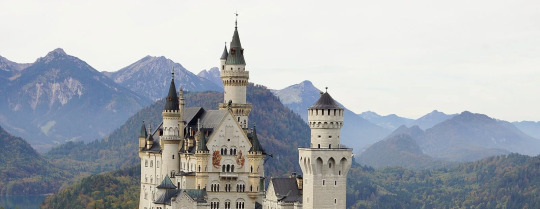
part 2
Some Castle Tropes
Big Fancy Castle: Big, elaborate, and visually impressive castles.
Bright Castle: Bright castle that signifies a good place, usually.
Good Castles, Evil Castles: Character Alignment as displayed on castle designs.
Haunted Castle: A derelict castle home to the dead or undead.
Ice Palace: A castle sculpted from ice.
Monster in the Moat: Castles with water monsters living in their moats.
Ominous Floating Castle: A visually imposing, intimidating castle floating in the sky, outer space, or an otherworldly void.
Palatial Sandcastle: A sandcastle you can live in.
Storming the Castle: A climatic assault on a fortified base.
Castles & similar structures in other parts of the world
Central and parts of Eastern Europe. Here castles weren't much different from the Western European ones. The only difference is that the local castle-building tradition was not so old; there are no Early Medieval castles in Eastern Europe, and the oldest were built during the High Middle Ages.
Russia. This country's tradition of fortification is a bit different; the rural castle never caught on here. Urban castles and citadels, called kremlins, on the other hand, were quite widespread. Kremlin is not the name of one specific famous citadel, it's a generic term for a city castle. This country also has some Romantic revival castles; these are likely to be found in rural areas.
Japan. Japanese castles, named shiro, are remarkably different in architecture from European ones, because they were built to protect the local feudal lords from local siege tactics, which differed significantly from classic medieval European sieges. Most notably, firearms found a very slow and lukewarm welcome in feudal Japan's Samurai culture, and their introduction only stimulated castle building rather than put an end to it.
The Near East. Castles were introduced to this area by the crusaders, and, were completely based on European designs. However, citadels had been common for centuries, particularly in the Levant (which had been one of the most fought-over regions in the world basically since people could write); although most surviving Middle Eastern citadels date from the Crusader period or just before, one, the Tower of David in Jerusalem, has been a citadel since the 2nd century BCE (albeit one that kept getting destroyed and rebuilt, like the rest of the city).
India. This country's equivalents of castles are called durga in Sanskrit or qila in Hindi. These words were usually translated as "forts", because they were used as army forts by the British colonial army, but they were originally castles.
Southern Africa. The castles in this region were built by the Dutch and German settlers, and aren't much different from those found in Western Europe. While the castles here aren't very old, they tend to be mimicries of the Medieval style.
Examples of Castles around the World
Neuschwanstein. The archetypical Romantic revival castle, it was built by the eccentric king Ludwig of Bavaria ("Mad King Louie" or the "Moon King") when Bavaria was actually part of the federal German Empire but retained its status as an "independent realm." Everyone might recognize this castle as the one shown in the Disney logo and copied in Disneyland parks as the "Sleeping Beauty Castle". This is not surprising, because Ludwig purposefully designed this castle as the fairy-tale castle of his dreams. It is a very popular tourist spot.
St. Michael's Castle, St. Petersburg. Another revival castle, this one is unique in many ways. First, despite being a revival castle, it had a genuine defensive function: it was built by a Properly Paranoid Russian emperor Paul I to serve as his highly secure residence. Second, it has a unique "four-sided" architecture: the four facades of this quadrangular castle show different architectural styles each, from neo-gothic and pseudo-medieval to generic XVIII century palace. It didn't serve its intended function, its owner was killed by conspirators, the castle's defensive moat was filled with ground and it was repurposed as an engineering school (hence its second name, Engineer's Castle). Currently it houses the Russian Museum of Art and is open for visitors.
Krak des Chevaliers, Syria. The archetypical Crusader castle in the Near East, one of the largest and the most well-preserved (until recently). This large concentric castle belonged to the Order of Knights Hospitaller, a famous order of knights who guarded the safety of pilgrims in the Holy Land and eventually evolved into the Sovereign Order of Malta, which still exists to this day.
Sources: 1 2 ⚜ Parts & Types of Castles ⚜ Writing Resources PDFs ⚜ Part 1
#writing reference#castle#worldbuilding#writeblr#dark academia#spilled ink#literature#writers on tumblr#writing prompt#poets on tumblr#creative writing#fiction#light academia#writing inspiration#writing ideas#writing resources
118 notes
·
View notes
Text
The Snuff Box
I want to take a moment to talk about one of my favorite anatomical areas. I mean areas, as in arbitrary things like Hesselbach's triangle, the quadrangular space, the delto-pectoral triangle, and the...anatomical snuff box.
This is a region on the dorsal surface of the base of the thumb. It's a nice little triangle that appears when you abduct and extend your thumb. The tendons that make up the borders are the extensor pollicis longus (medial border), the extensor pollicis brevis, and the abductor pollicis longus. Within the triangle runs the radial artery and the superficial branch of the radian nerve. Under those structures are the scaphoid and trapezium (carpal bones), which can sometimes fracture when people fall on an outstretched hand.
Below the cut is my shitty diagram. But also, the reason this is called the snuff box is because it's a great little divot to hold cocaine powdered tobacco when you want to sniff it.
Correction: snuff is apparently powdered tobacco, and not cocaine. I don't think anyone sniffs snuff anymore, and you can still use this triangle to hold your coke.

17 notes
·
View notes
Text
Any idea is a potential world. Really. Commonality Part I (the Geography).
While rummaging through a drawer, I came across a scrambled Rubik's Cube. Now like the average person, I can't solve the puzzle but kept fiddling with it regardless. As the blocks continued to shuffle and click, it set off an idea that turned into a whole world.
The name of this post and subsequent follow-ups will be Project Commonality. So stay tuned for regular updates. What is the closest thing to a Rubik's Cube we can relate to? The answer lies right in front of us, rather we live on the answer. A small rock floating in space, neatly divided into quadrangular segments by imaginary lines. Earth is divvied by latitudes and longitudes.

These segments are called Graticules (technical term, I checked). How does this tie into a Rubik's Cube? Well, like how every piece on the cube turns, let's have the graticules turn around, shall we? Imagine Earth where the graticules turn at periodic intervals vertically and horizontally like a Rubik's Cube. Also like a Rubik's cube we have to make the opposite central squares immobile, that is the North and South Poles.
So we have a world in which chunks are moving freely (except immobile ones), now for that to happen in some realistic sense let's make sure each graticule is its own tectonic plate (which slides down all the way into the mantle from the crust) that is capable of moving freely across the mantle.
We have boundaries made, but can they be expanded upon? Let's jump deeper into the scientific aspect itself. There are 4 spheres- atmosphere, lithosphere, hydrosphere, and biosphere each representing air, land, water, and life respectively.

Since life (the carbon-based one we are very familiar with) originates within the water, it's very reasonable to merge both spheres onto the same lines. Meanwhile, lines denoting atmosphere and lithosphere will always be apart. Since water and aquatic life are continuously connected across the latitudes there will be continuous oceans along the laterals (East-West) of the world.
What about the atmosphere, lithosphere lines then which represent thematic opposites? How about we create a literal divide (contrasting the literal combination of hydrosphere and biosphere)?
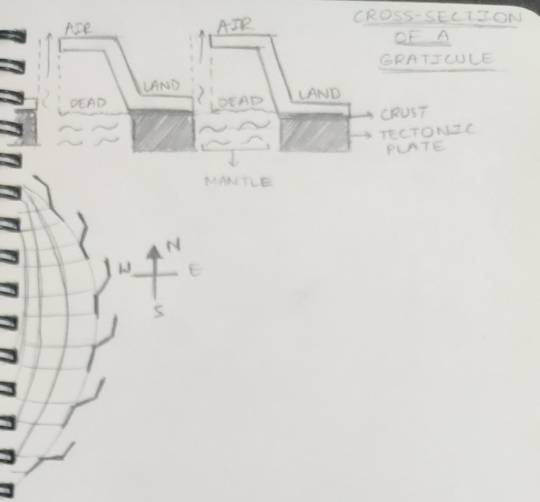
From the image, we can see the world's graticules divided into continuous steps. Each unit has an altitude rise as we move north along the graticule, a common apex height, and then an abrupt drop into a gap where lava erupts from large geysers (these develop rock caps that blow open as the graticule moves and cool down again into caps). Beyond the lava lies the next graticule and its lowest point where this trend is repeated again. This continues throughout the world. The dead space is empty, mostly uninhabitable land that is exposed to lava outbursts as wind is funneled from the top of the graticule downwards, resulting in pushing lava into the dead zone. These lava eruptions also make contact between North-South graticules next to impossible while East-West graticules can easily interact as they are connected primarily by water and don't have the mantle bursting regularly.
From the picture below we can see how the world looks like a giant, spiky ball that constantly shifts. The altitude gradients support the wind flow and how air would result in accumulating lava periodically in the dead zone.
Due to this interesting structure, the people of the world mostly interact only along the East-West direction while never attempting North-South contact due to inherent risk.
This behavior will give rise to many different peoples, ideologies, and cultures which we will be detailed in the following parts with inspirations different from the Rubik's Cube.
Stay tuned for the next part. Releasing soon! Mr. Real Make
2 notes
·
View notes
Text
Explore the anatomy of the quadrangular space, a key region in the posterior axilla. Understand its boundaries, neurovascular contents, and the clinical impact of quadrangular space syndrome. Ideal for medical students and professionals.
0 notes
Text

(12-2024) Audioguide: National Archaeological Museum of Arcevia (Marche, Italy)
for:

recorded at:

audioguide narration by: Edwin Alexander Francis

The National Archaeological Museum of Arcevia is located inside the thirteenth century cloister of the San Francesco complex, a quadrangular space with porticos on all sides overlooked by the rooms of the Museum and the Municipal cultural centre.


Remains of frescos from the sixteenth century that tell the story of the life of Saint Francis of Assisi can still be seen on the walls. The State Archaeological Museum of Arcevia was founded in 1996 on the initiative of the Archaeological Superintendency of the Marche and the Municipality of Arcevia as a district museum that exhibits finds from the territory of Arcevia. Since 2004, it has housed the Monti Anselmi collection and grave goods from the necropolis of Montefortino di Arcevia. The museum and the archaeological collection were redesigned in an innovative refurbishment in 2023 with the aim of improving accessibility. The exhibition tour has also been enriched with new materials. The display cases have a space in the front for captions, texts in braille and fibreglass copies or experimental archaeology reproductions of a number of important finds.




POI #17: Montefortino di Arcevia: the weapons
Swords, spears, javelins, bronze and iron helmets accompany the male depositions of the Senones in the necropolis of Montefortino. The exceptionally numerous weapons identify the deceased as a warrior and, in particular, the sword marks the status of a free man. Among the defensive weapons, a typical example is the helmet with a pointed or hemispherical cap and a button on the top, a neck guard and two cheek-pieces, internally lined with leather or wickerwork. It is known as the “Montefortino type” and was widespread in the Etruscan-Italic world before also being adopted by the Roman army. The iron helmet exhibited here underwent a major restoration in 2018. You can touch the life-size reproduction in fibreglass. The copy is 20 cm high. The rounded cap ends in a point in the upper part with a 1.4 cm high button that has a diameter of 3 cm. The neck guard is separated from the cap by means of a rib and does not protrude very much. The cheek-pieces, also known as cheek guards, protected the sides of the face. They were removable, trefoil in shape and joined to the cap by a strap, replacing the original fastening system, since lost. The cheek-pieces are around 13 cm high and 12 cm wide. Both are made up of a metal sheet, iron in the original, decorated with three bronze disks forming a triangle, fitted with rivets with hemispherical heads adorned with a red enamelled rosette. Each disk is decorated with with ring and cross motifs.



POI #20 Mirror, mirror on the wall...
The bronze mirror reproduced in its original size comes from female tomb 39. This is an exquisite artefact of Etruscan production. Circular in shape, it has a diameter of 17.5 cm and a tongue-shaped shank with a rectangular cross-section but lacks the handle, which may have been bone or ivory. It bears a complex engraved decoration on one face, made up of a group of four figures. A naked young man at the centre is wearing only a cloak tied at the neck that falls down his back. His hair is the shape of a cap with a crown of curls. He grasps and raises up with both hands a naked female figure, who moves to the right looking behind her. Their gazes intertwine in the faces in profile. The woman has a diadem on her head and her hair is gathered at the neck. She is wearing a necklace of circular beads and stud earrings with triangular pendants. Her movements are sinuous: the right arm is held out towards the man, the left hangs at the side of the body. Her legs are crossed and she wears low footwear. Two figures at the sides watch the scene. On the right, a naked man with a cloak around his shoulders holds a sceptre that ends in a lotus flower. On the left, a naked woman with the same ornaments as the central figure is caught in the act of anakalypsis , that is, unveiling. In the exergue, there is a lattice motif and a lotus flower. The scene has strong erotic and sensual nature and has been interpreted as the abduction of Thetis by Peleus in the presence of a Nereid or sea nymph and a male figure.

Arcevia (Marche, Italy)

POI #7: Conelle: a fortified village
The long, deep artificial ditch, dug by the small community that lived here between 3500 and 2950 B.C., is better preserved and of greater importance for the information it provides. This trench, 120 metres long, 7 metres deep at the lowest point and 6 metres wide at the surface, had a funnel-shaped section and was designed to protect the settlement, already defended naturally on two sides by escarpments carved out by small watercourses. When the expansion of the settlement became necessary, probably due to an increase in population, the ditch became an obstacle and was filled in, becoming an enormous dumping ground of materials that is an invaluable source of information today. Tools of everyday life used in the subsistence economy can be seen in the first display case. One example is the stone axe hammer found in fragments. A life-size fibreglass copy, the missing parts of which have been reconstructed, is attached to the front stand of the display case. The axe, 20 cm long and 8.5 cm wide, is mounted on a haft, originally made of wood, with a diameter of around 1.8 cm. The toe is on the left and the heel on the right. This tool, made for domestic use, could also serve as a weapon. Animal remains found in the ditch are exhibited in the second display case. These are the bones of wild animals such as boars, fallow deer, roe deer, foxes, wolves and bears, and domestic animals, such as cattle, pigs and goats. On the right of the captions, there is a life-size reproduction of a fragment of deer antler, 19 cm long and 3.5 cm wide. Traces of the process of polishing the horn can be seen on the tip. A through hole in the thicker end indicates its probable use as a horse bit.




0 notes
Text
Song of Myself (1892 version)
BY WALT WHITMAN
[…]
33
Space and Time! now I see it is true, what I guess’d at, What I guess’d when I loaf’d on the grass, What I guess’d while I lay alone in my bed, And again as I walk’d the beach under the paling stars of the morning.
My ties and ballasts leave me, my elbows rest in sea-gaps, I skirt sierras, my palms cover continents, I am afoot with my vision.
By the city’s quadrangular houses—in log huts, camping with lumbermen, Along the ruts of the turnpike, along the dry gulch and rivulet bed, Weeding my onion-patch or hoeing rows of carrots and parsnips, crossing savannas, trailing in forests, Prospecting, gold-digging, girdling the trees of a new purchase, Scorch’d ankle-deep by the hot sand, hauling my boat down the shallow river, Where the panther walks to and fro on a limb overhead, where the buck turns furiously at the hunter, Where the rattlesnake suns his flabby length on a rock, where the otter is feeding on fish, Where the alligator in his tough pimples sleeps by the bayou, Where the black bear is searching for roots or honey, where the beaver pats the mud with his paddle-shaped tail; Over the growing sugar, over the yellow-flower’d cotton plant, over the rice in its low moist field, Over the sharp-peak’d farm house, with its scallop’d scum and slender shoots from the gutters, Over the western persimmon, over the long-leav’d corn, over the delicate blue-flower flax, Over the white and brown buckwheat, a hummer and buzzer there with the rest, Over the dusky green of the rye as it ripples and shades in the breeze; Scaling mountains, pulling myself cautiously up, holding on by low scragged limbs, Walking the path worn in the grass and beat through the leaves of the brush, Where the quail is whistling betwixt the woods and the wheat-lot, Where the bat flies in the Seventh-month eve, where the great gold-bug drops through the dark, Where the brook puts out of the roots of the old tree and flows to the meadow, Where cattle stand and shake away flies with the tremulous shuddering of their hides, Where the cheese-cloth hangs in the kitchen, where andirons straddle the hearth-slab, where cobwebs fall in festoons from the rafters;
Where trip-hammers crash, where the press is whirling its cylinders, Wherever the human heart beats with terrible throes under its ribs, Where the pear-shaped balloon is floating aloft, (floating in it myself and looking composedly down,) Where the life-car is drawn on the slip-noose, where the heat hatches pale-green eggs in the dented sand, Where the she-whale swims with her calf and never forsakes it, Where the steam-ship trails hind-ways its long pennant of smoke, Where the fin of the shark cuts like a black chip out of the water, Where the half-burn’d brig is riding on unknown currents, Where shells grow to her slimy deck, where the dead are corrupting below; Where the dense-starr’d flag is borne at the head of the regiments, Approaching Manhattan up by the long-stretching island, Under Niagara, the cataract falling like a veil over my countenance, Upon a door-step, upon the horse-block of hard wood outside, Upon the race-course, or enjoying picnics or jigs or a good game of base-ball, At he-festivals, with blackguard gibes, ironical license, bull-dances, drinking, laughter, At the cider-mill tasting the sweets of the brown mash, sucking the juice through a straw, At apple-peelings wanting kisses for all the red fruit I find, At musters, beach-parties, friendly bees, huskings, house-raisings; Where the mocking-bird sounds his delicious gurgles, cackles, screams, weeps, Where the hay-rick stands in the barn-yard, where the dry-stalks are scatter’d, where the brood-cow waits in the hovel, Where the bull advances to do his masculine work, where the stud to the mare, where the cock is treading the hen, Where the heifers browse, where geese nip their food with short jerks, Where sun-down shadows lengthen over the limitless and lonesome prairie,
Where herds of buffalo make a crawling spread of the square miles far and near, Where the humming-bird shimmers, where the neck of the long-lived swan is curving and winding, Where the laughing-gull scoots by the shore, where she laughs her near-human laugh, Where bee-hives range on a gray bench in the garden half hid by the high weeds, Where band-neck’d partridges roost in a ring on the ground with their heads out, Where burial coaches enter the arch’d gates of a cemetery, Where winter wolves bark amid wastes of snow and icicled trees, Where the yellow-crown’d heron comes to the edge of the marsh at night and feeds upon small crabs, Where the splash of swimmers and divers cools the warm noon, Where the katy-did works her chromatic reed on the walnut-tree over the well, Through patches of citrons and cucumbers with silver-wired leaves, Through the salt-lick or orange glade, or under conical firs, Through the gymnasium, through the curtain’d saloon, through the office or public hall; Pleas’d with the native and pleas’d with the foreign, pleas’d with the new and old,
Pleas’d with the homely woman as well as the handsome, Pleas’d with the quakeress as she puts off her bonnet and talks melodiously, Pleas’d with the tune of the choir of the whitewash’d church, Pleas’d with the earnest words of the sweating Methodist preacher, impress’d seriously at the camp-meeting; Looking in at the shop-windows of Broadway the whole forenoon, flatting the flesh of my nose on the thick plate glass, Wandering the same afternoon with my face turn’d up to the clouds, or down a lane or along the beach, My right and left arms round the sides of two friends, and I in the middle; Coming home with the silent and dark-cheek’d bush-boy, (behind me he rides at the drape of the day,) Far from the settlements studying the print of animals’ feet, or the moccasin print,
By the cot in the hospital reaching lemonade to a feverish patient, Nigh the coffin’d corpse when all is still, examining with a candle; Voyaging to every port to dicker and adventure, Hurrying with the modern crowd as eager and fickle as any, Hot toward one I hate, ready in my madness to knife him, Solitary at midnight in my back yard, my thoughts gone from me a long while, Walking the old hills of Judæa with the beautiful gentle God by my side, Speeding through space, speeding through heaven and the stars, Speeding amid the seven satellites and the broad ring, and the diameter of eighty thousand miles, Speeding with tail’d meteors, throwing fire-balls like the rest, Carrying the crescent child that carries its own full mother in its belly, Storming, enjoying, planning, loving, cautioning, Backing and filling, appearing and disappearing,
I tread day and night such roads.
I visit the orchards of spheres and look at the product, And look at quintillions ripen’d and look at quintillions green.
I fly those flights of a fluid and swallowing soul, My course runs below the soundings of plummets.
I help myself to material and immaterial, No guard can shut me off, no law prevent me.
I anchor my ship for a little while only, My messengers continually cruise away or bring their returns to me.
I go hunting polar furs and the seal, leaping chasms with a pike-pointed staff, clinging to topples of brittle and blue. I ascend to the foretruck, I take my place late at night in the crow’s-nest, We sail the arctic sea, it is plenty light enough, Through the clear atmosphere I stretch around on the wonderful beauty, The enormous masses of ice pass me and I pass them, the scenery is plain in all directions, The white-topt mountains show in the distance, I fling out my fancies toward them, We are approaching some great battle-field in which we are soon to be engaged, We pass the colossal outposts of the encampment, we pass with still feet and caution, Or we are entering by the suburbs some vast and ruin’d city, The blocks and fallen architecture more than all the living cities of the globe.
I am a free companion, I bivouac by invading watchfires, I turn the bridegroom out of bed and stay with the bride myself, I tighten her all night to my thighs and lips.
My voice is the wife’s voice, the screech by the rail of the stairs, They fetch my man’s body up dripping and drown’d.
I understand the large hearts of heroes, The courage of present times and all times, How the skipper saw the crowded and rudderless wreck of the steam-ship, and Death chasing it up and down the storm, How he knuckled tight and gave not back an inch, and was faithful of days and faithful of nights, And chalk’d in large letters on a board, Be of good cheer, we will not desert you; How he follow’d with them and tack’d with them three days and would not give it up, How he saved the drifting company at last, How the lank loose-gown’d women look’d when boated from the side of their prepared graves, How the silent old-faced infants and the lifted sick, and the sharp-lipp’d unshaved men; All this I swallow, it tastes good, I like it well, it becomes mine, I am the man, I suffer’d, I was there.
The disdain and calmness of martyrs, The mother of old, condemn’d for a witch, burnt with dry wood, her children gazing on, The hounded slave that flags in the race, leans by the fence, blowing, cover’d with sweat, The twinges that sting like needles his legs and neck, the murderous buckshot and the bullets, All these I feel or am.
I am the hounded slave, I wince at the bite of the dogs, Hell and despair are upon me, crack and again crack the marksmen, I clutch the rails of the fence, my gore dribs, thinn’d with the ooze of my skin, I fall on the weeds and stones, The riders spur their unwilling horses, haul close, Taunt my dizzy ears and beat me violently over the head with whip-stocks.
Agonies are one of my changes of garments, I do not ask the wounded person how he feels, I myself become the wounded person, My hurts turn livid upon me as I lean on a cane and observe.
I am the mash’d fireman with breast-bone broken, Tumbling walls buried me in their debris, Heat and smoke I inspired, I heard the yelling shouts of my comrades, I heard the distant click of their picks and shovels, They have clear’d the beams away, they tenderly lift me forth.
I lie in the night air in my red shirt, the pervading hush is for my sake, Painless after all I lie exhausted but not so unhappy, White and beautiful are the faces around me, the heads are bared of their fire-caps, The kneeling crowd fades with the light of the torches.
Distant and dead resuscitate, They show as the dial or move as the hands of me, I am the clock myself. I am an old artillerist, I tell of my fort’s bombardment,
I am there again.
Again the long roll of the drummers, Again the attacking cannon, mortars, Again to my listening ears the cannon responsive.
I take part, I see and hear the whole, The cries, curses, roar, the plaudits for well-aim’d shots, The ambulanza slowly passing trailing its red drip, Workmen searching after damages, making indispensable repairs, The fall of grenades through the rent roof, the fan-shaped explosion, The whizz of limbs, heads, stone, wood, iron, high in the air.
Again gurgles the mouth of my dying general, he furiously waves with his hand, He gasps through the clot Mind not me—mind—the entrenchments.
0 notes
Photo


QUADRANGULAR SPACE
Boundaries
Medially - long head of triceps
Laterally - surgical neck of humerus
Inferiorly - teres major
Superiorly
Subscapularis (anteriorly)
Teres minor (posteriorly)
CONTENTS - Axillary nerve & posterior circumflex humeral vessels
1 note
·
View note
Text

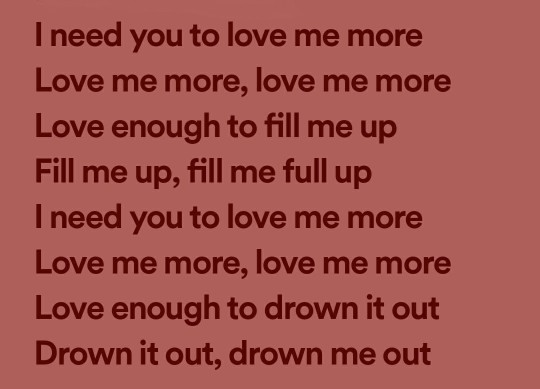

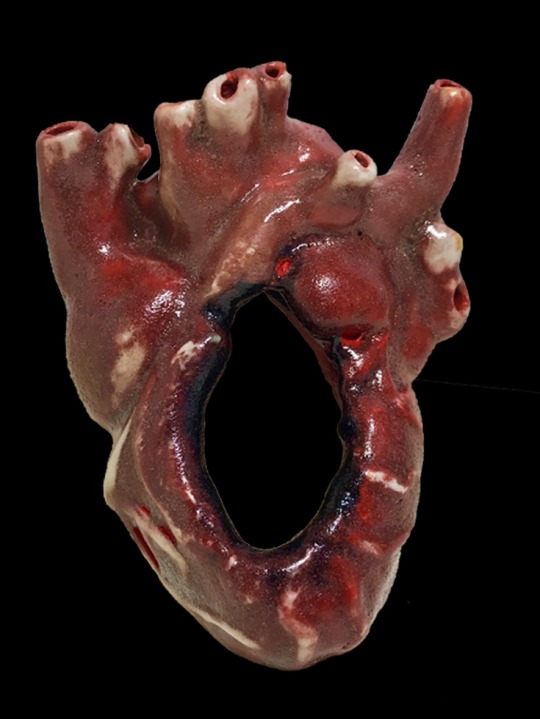






ALL THESE TWENTY YEARS TRYING TO FILL THE VOID
As Consciousness Is Harnessed to Flesh by Susan Sontag x || Love Me More by Mitski || I’m Lazy, Reckless, and Addicted to Social Media. Help! by Heather Havrilesky || artwork by @blluish x || The Singing by Kim Addonizio x || My Solo Exchange Diary (Hitori Koukan Nikki) by Kabi Nagata || The Drama of the Gifted Child by Alice Miller, trans. by Ruth Ward || Remember My Name by Mitski || artwork by @blluish x || Humpty by Mitski
transcription under the cut
[ID:
1 : "I, in my corner, with my monstrous needs.", underlined in red
2: "I need you to love me more / Love me more, love me more / Love enough to fill me up / Fill me up, fill me full up / I need you to love me more / Love me more, love me more / Love enough to drown it out / Drown it out, drown me out". Dark red text on red background.
3: "You’re exhausted because [highlight-start] you’re looking for love every second of every day, in everything you do. [highlight-end]". Black on white; gray highlight.
4: Photograph of a ceramic sculpture of an anatomical heart. There is a big, roundish hole in its center. The heart is painted red and white to resemble the color of flesh; it darkens nearing the edge of the hole, which are black. The background is black.
5: "I don’t know what I want, only that I’m desperate for it, that I can’t stop asking." . The pic is a screenshot of an indented tumblr textpost, background set in dark mode.
6: It’s a manga comic strip that reads from right to left. It opens with a quadrangular text box: “Every part of me started going cold.”. In the middle of the strip are drawn three scenes of life, which depict a shivering woman with a bob cut (the protagonist) struggling to warm herself up: she hugs herself in a blanket near a heater (1), she bathes in hot water (2), she buries herself under a futon dryer (3). Near each scene there’s written, in order,: “HEATER” (1), “BATH” (2), “FUTON DRYER” (3). Over the third scene, with an arrow pointing to it, there is an additional text that reads: “APPARENTLY, YOU’RE NOT SUPPOSED TO DO THIS…”. The strip closes with another quadrangular text box: “No matter what I did, I couldn’t warm up”. The blanket, the hot water and the futon, all in pink, are the only colored parts of the strip.
7: “It is thus impossible for the grandiose person to cut the tragic link between admiration and love. In his compulsion to repeat [underline-start] he seeks insatiably for admiration, of which he never gets enough because admiration is not the same thing as love. It is only a substitute gratification of the primary needs for respect, understanding, and being taken seriously —needs that have remained unconscious. [underline-end]”. After a line of blank space, the text continues: “ [...]If his success the previous night only serves as the denial of childhood frustrations, then, like every substitute, it can only bring momentary satiation. [underline-start]In fact, true satiation is no longer possible, since the right time for that now lies irrevocably in the past. [underline-end]The former child no longer exists, nor do the former parents. The present parents—if they are”. Black on white.
8: “[highlight-start] I need something bigger than the sky /Hold it in my arms and know it's m
ine [highlight-end] / Just how many stars will I need to hang around me / To finally get somewhere I can be all done / Somewhere like heaven”. Black on white; pink highlight.
9: Photograph of a ceramic sculpture of the nude upper body of a woman. She has pale skin, black length shoulder black hair with bangs and closed eyes. Her expression is one of resignation, sorrow and hopelessness. Like in the heart before, there is a big roundish hole through the middle of her chest. It’s edges are red, though, and the color slowly fades on the skin. It’s the same shade of red of her cheeks (that goes up to her eyes, making her look like she has just finished crying), mouth, nose and chin. The background is black.
10: “I broke what you gave me / But you kept giving more / And I'm sorry for taking / [highlight-start] But I keep wanting more, more, more, oh [highlight-end]”. Black on white; dark gray highlight over white text.
/END ID]
#web weaving#parallels#on hunger#starved for love#mitski#laurel hell#love me more#remember my name#humpty#susan sontag#heather havrilesky#kim addonizio#kabi nagata#alice miller#as consciousness is harnessed#dear polly#the singing#my solo exchange diary#hitori koukan nikki#the drama of the gifted child#mine#ok so. i realize some of these (kabi nagata) make sense only to me. and that's fine. i made this for me. to exorcise a feeling.#or welcome it as it is.#i feel like im forgetting something but i dont know what. anyways.
3K notes
·
View notes
Text
More than Seaweeds
Mermaid's Herbal Compendium

Navigation: Masterlist✦Ask Rules✦Feedback Tips
Askbox✦Sources✦Paid Readings

Name: Basil
Scientific name: Ocimum selloi Benth.
Disclaimer: As English is not my native language, there may be some errors in scientific expressions. I am also using local resources.
TECHNICAL USAGE
History:
Due to the shape of its leaves (heart), it was considered a symbol of love in Italy and of mourning in Greece. (Portal São Francisco, 2016)
4,000 years ago, the Hindus, who were percussionists in the culture of basil, exported it to Egypt. (Portal São Francisco, 2016)
In the last century, basil was used by shoemakers to attenuate the smell of leather. (Portal São Francisco, 2016)
The name "basilicum" has its origin in the Greek "basilikós," which means "of the kings or royal," to indicate its nobility. The Greek botanist Theophrastus, in the 3rd century BC, defined basil as an herb of kings. (History of Ingredients, 2016)
Description:
Plant characteristics: Basil is an herbaceous plant grown in gardens and widely known throughout Brazil. It is characterized by the pleasant smell that is released from its leaves. It has a quadrangular stem, and the leaves are opposite, sharp, and abundant. The plant produces small white flowers arranged on an elongated axis, with secondary inflorescences formed on each axis. The corolla has four pieces, and the plant bears fruit with four dark nuclei. It is a meliferous plant. Basil can be propagated by seeds or cuttings taken from the branches. It thrives in fertile soils rich in organic matter, permeable, and with high temperatures. (Treatise on Medicinal Plants, 2014)
Propagation: Basil can be propagated by seeds or cuttings from branches. Basil seeds are sown in 200-cell expanded polystyrene trays containing commercial substrate and kept in protected cultivation. At 30 days after sowing, the seedlings have four definitive leaves and are suitable for transplanting. (PEREIRA; MOREIRA, 2011)
Cultivation: Seedlings can be planted in pots or nurseries throughout the year. For this, the beds must be well prepared, raised to a height of 15 cm. Use 150 g of well-tanned bovine manure per square meter of bed and mix well. Sow the seeds and cover with 0.5 cm of light soil or fine sawdust. The recommended spacing is 30 cm between lines and 30 cm between plants. Irrigate at least once a day, preferably in the early morning or late afternoon. After 60 days of planting in the beds, the first harvest can be made by cutting the plant at 20 cm from the soil. (PEREIRA; MOREIRA, 2011)
How to choose and where to find:
Fresh: Fresh bunches and pots of basil can be found in fairs, markets, and supermarkets. Choose branches with lush leaves that are not stained or wilted.
Dry: Dry basil can be found in supermarkets and specialty stores. Look for products in dark packaging, protected from light, to prevent loss of aroma. Check the expiration date.
How to Store:
Fresh:
Basil spoils quickly, but it can be packed in plastic packaging and dried for up to three days at most.
Chop the leaves and place them in a closed glass container with oil.
Dry: Store in a sealed container, away from light and humidity.
How to dry:
Buy two large bundles of basil, wash them well, and spread them on a clean cloth until dry.
Separate the leaves and make layers of leaves in a glass bowl, alternating with thin layers of coarse salt.
Cover the glass bowl with plastic wrap and leave it at room temperature.
Stir once a day for the first three days.
The dried basil can be used for up to two months. The leaves become dry, and the salt absorbs the aroma of basil. You can use only the leaves or also the coarse salt.
Chemical Composition:
Tannins: Tannins are astringent and hemostatic, and their therapeutic applications are related to these properties. They are mainly used in the tanning and paint industries. They are also used in laboratories to detect proteins and alkaloids and as antidotes in cases of poisoning by alkaloid plants.
Flavonoids: The therapeutic functions of flavonoids are not yet fully understood. The group is known for its anti-inflammatory, anti-allergic, and vasoprotective effects (treatment of thrombosis). Rutin and hesperidin are important flavonoids used in the treatment of capillary fragility.
Saponins: Saponoside glycosides are named for their ability to form abundant foam when agitated with water (from Latin "frog" = soap). They taste bitter and acrid, and drugs containing them are usually sternutatory (cause sneezing) and irritating to the mucous membranes. They are non-nitrogen compounds that dissolve in water, producing foaming solutions by decreasing the surface tension of the liquid. They also have the properties of emulsifying oils and causing hemolysis. The latter is due to the ability of the glycoside to combine with the cholesterol molecules present in the erythrocyte membrane, disrupting the internal-external balance and promoting the rupture of the cell, resulting in the release of hemoglobin.
Essential Oils:
o Thymol: It has carminative, anti-spasmodic, expectorant, and anti-inflammatory properties. It also has significant antiseptic potential. o Methyl-chavicol: It has antimicrobial, anti-inflammatory, local anesthetic, and insecticidal activities. o Linalool: It is used for its woody, floral, and refreshing aroma. o Eugenol: It has anesthetic, bactericidal, antifungal, and flavoring properties, with a hot and spicy note. o Cineol: It has decongestant and anti-inflammatory properties and gives a eucalyptus aroma. o Pyrene
Herbal Actions:
Digestant: An herb that promotes good digestion.
Carminative: Herbs or essential oils that help the intestines release gas by relaxing gut spasms and increasing peristalsis to expel gas.
Sweetener: It has the ability to sweeten.
Aperientes: Aperientes herbs are mild laxatives.
Indications: Basil is beneficial for those who have difficulties in digestion, gas, heartburn, and headaches resulting from heavy or inadequate food. It facilitates the functioning of the intestines and acts as a diuretic. It is good for coughs, vomiting, and bad breath. Along with malva and sage, it helps in mouth infections.
Dosage: There is little information on the safe and effective dosage of basil. Usually, 10 to 20 ml of fresh basil leaf juice is used once a day, or teas can be made by infusing 2 grams of fresh basil or dried herb in boiling water twice a day.
Contraindications: Basil is not suitable for long-term use in children, and it should not be used by pregnant women in the first three months of pregnancy.
MAGICAL USAGE
Gender: Masculine
Planet: Mars
Element: Fire
Deities: Ares, Eros, Zeus, Apollo, Vishnu, and Krishna
Tarot Cards: The Empress, Justice, Six of Swords, Ten of Cups
Zodiac: Virgo, Scorpio, Sagittarius
Sabbath: Yule, Imbolc
Magical Uses (under observation of effectiveness): Basil is linked to love, health, exorcism, and clairvoyance in magical practices. Its fresh leaves can be used as a natural scent to attract passion. Hanging some branches around the house can protect the environment and bring permanent joy. In some ancient cultures, basil was placed on the chest of the dead as a symbol of a passport to paradise. Fun fact: There are over 64 types of basil. (GORI, 2021)
Therapeutic and Enchanted Recipes:
PROSPERITY TEA:
INGREDIENTS: 1 teaspoon of basil, 1 teaspoon of thyme.
PREPARATION: Heat the water for 10 minutes, then turn off the heat. Add the basil and thyme and let it steep for 15 minutes.
CLAIRVOYANCE TEA:
INGREDIENTS: 1 teaspoon of basil, 1 teaspoon of hibiscus.
PREPARATION: Heat the water for 10 minutes, then turn off the heat. Add the basil and hibiscus and let it steep for 15 minutes. Drink four sips before your divination practices, especially oracles.
MIX OF HERBS FOR LOVE:
INGREDIENTS: 1 cup of basil, 1 cup of rose petals and buds, 1/2 cup of patchouli leaves, 1/2 cup of lavender flowers, 2 tablespoons of dragon's blood.
PREPARATION: Place this herbal mixture in a bowl in your home to attract love.
HAPPY SIPS:
*This is a recipe that makes me feel really happy...
INGREDIENTS: Fresh basil leaves, fresh strawberries.
PREPARATION: Make a flavored water by adding as much basil and strawberry as your heart desires. Let it sit for a while (to taste) and drink it. I used to make this a lot when working at the office, and it made me feel fresh and happy.
Sources:
CUNNINGHAM, Scott. Enciclopédia das Ervas Mágicas do Cunningham. 1ª ed. São Paulo: Editora Alfabeto, 2021.
PRIETO, Claudiney. Rituais de Magia com o Tarô. 1ª ed. São Paulo: Editora Alfabeto, 2021.
GORI, Tânia. Herbologia Mágica. 2ª ed. São Paulo: Editora Alfabeto, 2021.
CABOT, Laurie; CABOT, Penny; PENCZAK, Cristopher. Tradução de Virginia Dalbo. Livro de Feitiços de Laurie Cabot. 3ª ed. São Paulo. Editora Alfabeto, 2021.
LADDY, Brianna. Apostila Magia das Ervas. 2019. Her Instagram
LADDY, Brianna. 25 Feitiços usando a Magia das Ervas. 2021. Her Instagram
MINHAVIDA. Manjericão alivia problemas intestinais e tem ação anti-inflamatória. Disponível em: https://www.minhavida.com.br/materias/materia-11744#:~:text=Existe%20pouca%20informa%C3%A7%C3%A3o%20sobre%20a,fervente%20duas%20vezes%20ao%20dia. Acesso em: 11 abr. 2021.
SOCIEDADE BRASILEIRA DE FARMACOGNOSIA. Taninos. Disponível em: http://www.sbfgnosia.org.br/Ensino/taninos.html. Acesso em: 11 abr. 2021.
PARODI, Lorenzo. MANJERICÃO. Disponível em: http://www.ingredientes.blog.br/. Acesso em: 11 abr. 2021.
PORTAL SÃO FRANCISCO. Manjericão. Disponível em: https://www.portalsaofrancisco.com.br/alimentos/manjericao#:~:text=Devido%20%C3%A0%20forma%20de%20suas%20folhas%2C%20(cora%C3%A7%C3%A3o)%2C%20era,atenuar%20o%20cheiro%20do%20couro. Acesso em: 11 abr. 2021.
GRANDI, Telma Sueli Mesquita. Tratado das plantas medicinais [recurso eletrônico]: mineiras, nativas e cultivadas. 1. ed. – Dados eletrônicos. Belo Horizonte: Adaequatio Estúdio, 2014. (Download the book HERE)
HOFFMANN, David. Tradução Euclides Luiz Calloni. O guia completo das plantas medicinais: ervas de A a Z para tratar doenças; restabelecer a saúde e o bem-estar. 1ª ed. São Paulo: Cultrix, 2017.
(CC) AstroJulia Some Rights Reserved
#astrojulia#astrology#witchblr#astroblr#all about astrology#astro community#astro observations#astrology notes#witch community#herbology#all about witchcraft#herbs#basil#spells
82 notes
·
View notes
Photo
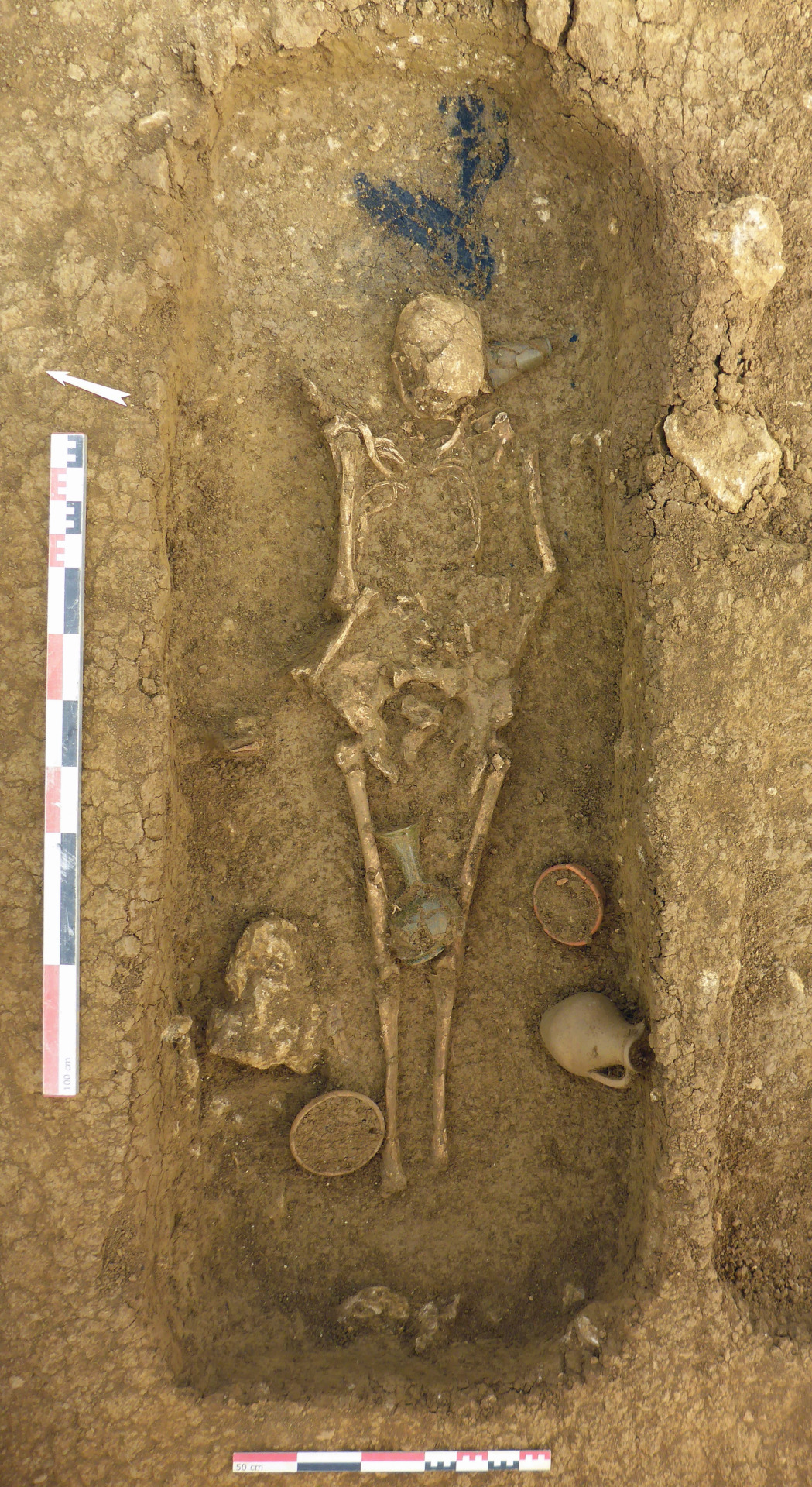
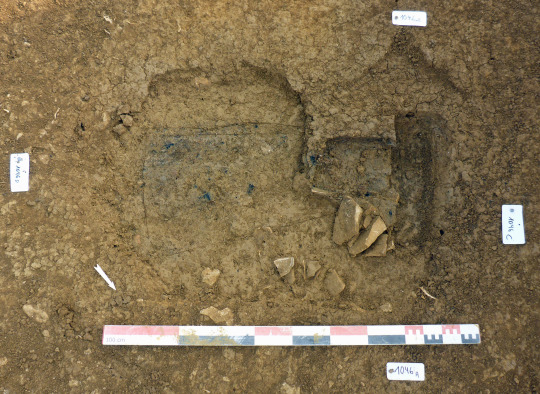
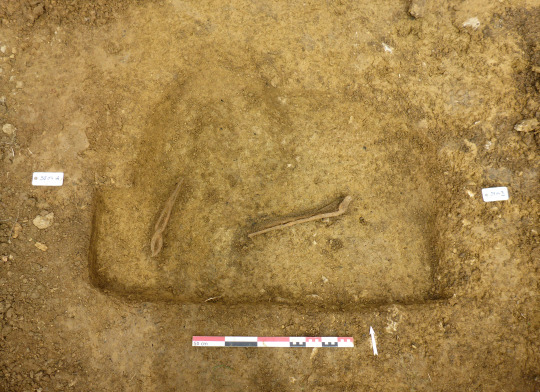
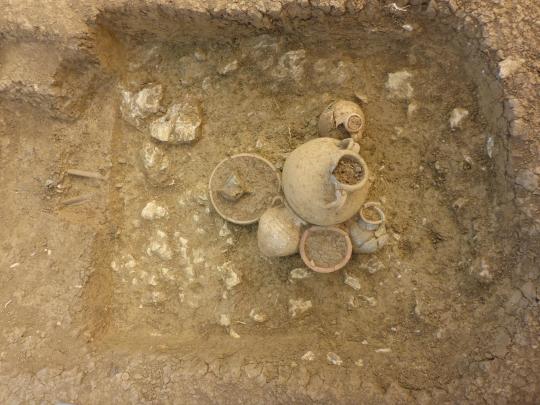

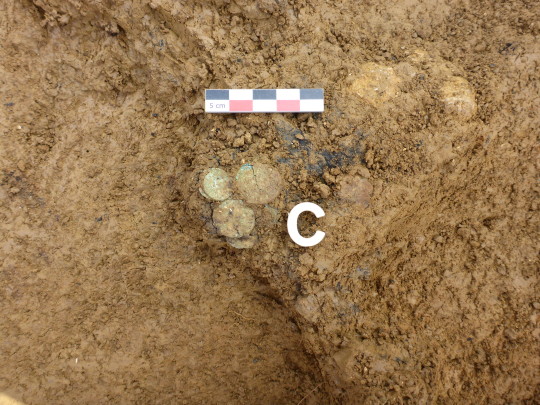
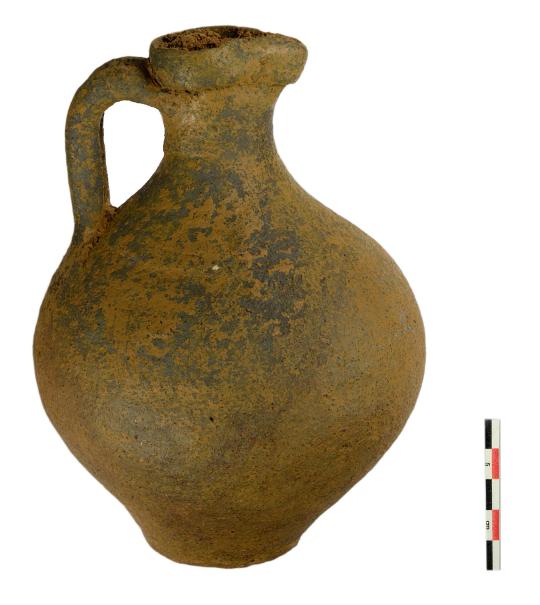
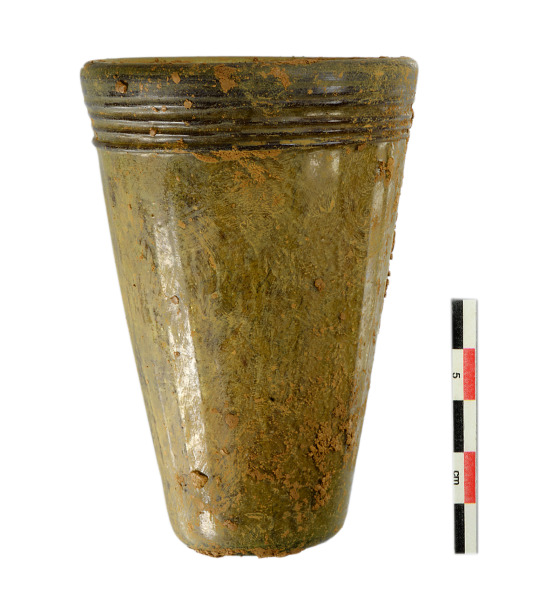
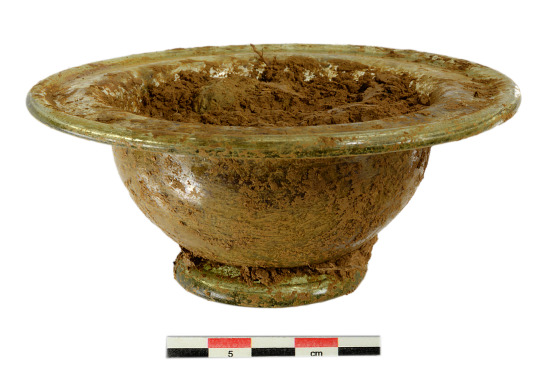
Roman Era Necropolis Found in France
A small rural necropolis from the late 5th century has been discovered in Sainte-Marie-aux-Chênes, northeastern France. Located along an ancient road, the necropolis contains the remains of cremation structures and several richly furnished inhumations. The burial ground is likely connected to a nearby ancient Roman villa whose remains were discovered more than a decade ago.
A survey of the site before construction of a subdivision in 2009 found evidence of archaeological material. In the two seasons of excavations that followed, archaeologists unearthed the remains of the pars rustica (the farm buildings) of a 1st century Roman villa and a Medieval hamlet occupied through the 12th century. Three Merovingian-era (mid-5th-8th c.) tombs containing the remains of seven people, all from the same family, were found in the ruins of a barn from the Roman estate.
Excavations resumed in 2020 when the subdivision planned to expand towards the former Ida mine and factory. Test pits discovered the first early Iron Age remains at the site attesting that the area was settled earlier than previously realized and a continuation of the Medieval hamlet into the valley. A cremation pit and a secondary deposit from the Gallo-Roman era were also uncovered. They date to the 1st century A.D.
The 2020 excavation explored the opposite side of the valley to the 2009-10 digs. The soil there has been heavily eroded, but that had the felicitous archaeological side-effect of accumulating sediment layers over the necropolis which helped preserve the remains. Digging through those layers, archaeologists unearthed about 10 cremation structures. Fragments of charred bone remains were found in carefully cut quadrangular pits and in much rougher round niches that look like postholes but aren’t. There are no cinerary urns and very little surviving bone material. A few nails were found, perhaps from a casket, and a square pit containing a deposit of blacksmithing tools and forge remnants (tongs, metal scraps, slag).
Ten tombs from Late Antiquity were found in this same space. The pits were dug with deliberation in parallel rows. All of the graves contained a single inhumed individual in supine position, adults of both sexes and four confirmed young children. Two adult women were identified by their hairpins and necklaces. While no coffins or burial beds were found in the graves, iron nails and wood traces suggest the bodies were originally buried in or on wooden biers.
The deceased were laid to rest with a variety of grave goods. Ceramic vessels made of local Argonne clay were found at the head and/or the foot of the bodies. They are believed to have contained food offerings now long decomposed. Glassware of high quality and diversity was also buried with the dead: cups, bottles, flasks, goblets, bowls, dishes. Jewelry — mostly copper alloy pieces with beads, amber and glass paste — adorned the deceased. There were coins in the graves as well, some individual, some in groups that were probably held in purses of organic material. Last but least, two bone combs were discovered and one miniature axe interred next to the head of a child.
The remains recovered from the excavation are still being studied. Researchers hope to learn more about the sex, ages and health records of the deceased. The necropolis itself is also still undergoing analysis to explore how it was organized and used, and to shed new light on the funerary practices of the people who lived and died their in Late Antiquity.
#Roman Era Necropolis Found in France#roman villa#ancient tomb#ancient grave#ancient artifacts#archeology#archeolgst#history#history news#ancient history#ancient culture#ancient civilizations#roman era#roman history#roman empire
24 notes
·
View notes
Photo


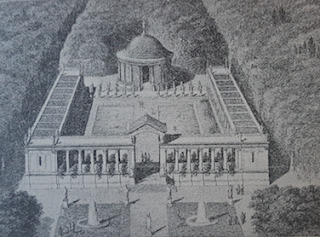

Various reconstructions of Varro’s aviary at Casinum as described in his work on Agriculture.
1. Sir John Soane
2. Pirro Ligorio
3 & 4. ?
From De Re Rustica, Volume 3:
I own, near the town of Casinum, a stream which runs through my villa, clear and deep, with a stone facing, 57 feet wide, and requiring bridges for passage from one side of the villa to the other; it is 950 feet in a straight line from the island in the lowest part of p453 the stream, where another stream runs into it, to the upper part of the stream, where the Museum is situated. 10 Along the banks of this stream there runs an uncovered walk 10 feet broad; off this walk and facing the open country is the place in which the aviary stands, shut in on two sides, right and left, by high walls. Between these lies the site of the aviary, shaped in the form of a writing-tablet with a top-piece,40 the quadrangular part being 48 feet in width and 72 feet in length, while at the rounded top-piece it is 27 feet. 11 Facing this, as it were a space marked off on the lower margin of the tablet, is an uncovered walk with a plumula41 extending from the aviary, in the middle of which are cages; and here is the entrance to the courtyard. At the entrance, on the right side and the left, are colonnades, arranged with stone columns in the outside rows and, instead of columns in the middle, with dwarf trees; while from the top of the wall to the archway the colonnade is covered with a net of hemp, which also continues from the archway to the base. These colonnades are filled with all manner of birds, to which food is supplied through the netting, while water flows to them in a tiny rivulet. 12 Along the inner side of the base of the columns, on the right side and on the left, and extending from the middle to the upper end of the open quadrangle, are two oblong fish-basins, not very wide, facing the colonnades. Between these basins is merely a path p455 giving access to the tholos, which is a round domed building outside the quadrangle, faced with columns, such as is seen in the hall of Catulus, if you put columns instead of walls. Outside these columns is a wood planted by hand with large trees, so that the light enters only at the lower part, and the whole is enclosed with high walls. 13 Between the outer columns of the rotunda, which are of stone, and the equal number of slender inner columns, which are of fir, is a space five feet wide. Between the exterior columns, instead of a wall there is a netting of gut, so that there is a view into the wood and the objects in it, while not a bird can get out into it. In the spaces between the interior columns the aviary is enclosed with a net instead of a wall. Between these and the exterior columns there is built up step by step a sort of little bird-theatre, with brackets42 fastened at frequent intervals to all the columns as bird-seats. 14 Within the nettings are all manner of birds, chiefly songsters, such as nightingales and blackbirds, to which water is supplied by means of a small trench, while food is passed to them under the netting. Below the base of the columns is stone-work rising a foot and nine inches above the platform;43 the platform itself rises about two feet above a pond, and is about five feet wide, so that the guests44 can walk in among the benches and the small columns. At the foot of the platform inside, is the pond, with a border a foot wide, and a little island in the middle. Along the platform also docks45 have been hollowed out as shelters for ducks. 15 On the island is a small column, and on the inside of it is a post, which holds up, instead of a table, a wheel p457 with spokes, in such fashion that on the outer rim, where the felloe usually stands, there is a curved board with raised edges like a tambourine, two and a half feet in width and a palm in height. This is revolved by a single manservant in such a way that everything to drink and eat is placed on it at once and moved around to all the guests. 16 From the side of the platform, on which there are usually coverlets,46 the ducks come out into the pond and swim about; from this pond a stream runs into the two fish-basins which I have described, and the minnows dart back and forth, while it is so arranged that cold and warm water flows for each guest from the wooden wheel and the table which, as I have said is at the ends of the spokes, by the turning of cocks.47 17 Inside, under the dome of the rotunda, the morning-star by day and the evening-star at night circle around near the lower part of the hemisphere, and move in such a manner as to show what the hour is. In the middle of the same hemisphere, running around the axis, is a compass of the eight winds, as in the horologium at Athens, which was built by the Cyrrestrian;48 and there a pointer, projecting from the axis, runs about the compass in such a way that it touches the wind which is blowing, so that you can tell on the inside which it is.
8 notes
·
View notes
Text
Historical Architecture: Alhambra, remnants of Islamic Spain.
One of the Iberian Peninsula’s and indeed European history’s more interesting chapters was the period of Islamic rule in the southwestern corner of Europe. For nearly 800 years there was a presence of Islamic governance in modern day Spain, Portugal and even parts of southern France. Rarely a unified Muslim state, it went through periods of changing dynasties, conflicts against the Crusading Christian kingdoms in the north known as the Reconquista as well a various civil wars with each other, alternating in competition and alliance with rival Christian powers as well as each other. Collectively, the name for Islamic Iberia as a geographic entity, period of history and culture was known as “Al-Andalus” which helped give rise to the modern day region of southern Spain “Andalusia”.
The rise of Islam in Iberia began with the 711 invasion of a mixed Berber (Amazigh) & Arab force from what is now Morocco into southern Spain. The Berbers were relatively new converts to Islam having been spread in the last half century across northern Africa. Lead by a Berber by the name of Tariq ibn Ziyad who served on behalf of the Umayyads Caliphate based out of Damascus Syria. The Umayyads were an Arab dynasty that replaced the Rashidun Caliphate which had formed after the death of the prophet Muhammad. The Rashiduns were the first Islamic Caliphate and spread across the Middle East & North Africa, the Umayyads became the second such caliphate and expanded their reach to Morocco and subsequently Europe with the invasion of Iberia in 711. Tariq and his force landed at what is now Gibraltar, with the modern name being a Spanish variation of the Arabic taking its name from Tariq, Gibraltar means “Mountain of Tariq”.
The invasion of the Umayyad overtook the Visigothic Kingdom that ruled over Iberia in the wake of the fall of the Western Roman Empire. The Visigoths were Germanic tribes who had migrated from northern Europe along with a host of other “barbarian” peoples in the waning days of the Western Roman Empire, this became known as the Age of Migration of the 4th & 5th centuries AD. Eventually the Western Roman Empire collapsed due to corruption, civil war and relentless waves of migratory peoples overwhelming parts of its territory. Germans, Celts, Slavs, Avars, Alans & Huns among others. In Iberia, the Visigoths who had sacked Rome itself but later converted to Christianity largely settled where they established their own kingdom and more or less assimilated with the Latin speaking majority of Roman colonists and Romanized Iberians and Celts who lived in Hispania as the Romans called it.
The Umayyads overran the Visigoths fairly quickly and within less than decade controlled most of the Iberian Peninsula. The exceptions being parts of the Basque country in the north and the so called Kingdom of the Asturias in northern Spain, protected by mountains. Here the Visigoths, increasingly Latinized in language and culture formed the first of many Christian kingdoms that ultimately successfully reversed Muslim rule on the peninsula in a slow 800 series of wars called the Reconquista.
Over those centuries numerous Muslim and Christian kingdoms and fiefdoms came and went, the most notable Muslim polity being the Emirate and later Caliphate of Cordoba which ruled from the city of Cordoba which in the Middle Ages was the largest city in all of Europe excepting Constantinople in the Byzantine Empire. Cordoba held roughly quarter to half a million people at its peak. It became a center of learning and culture, a true intellectual center in the so called Dark Ages. Scholars and artisans from the Muslim world and even Christian Europe studied in its libraries and learning institutions and the majority of Iberia’s population some estimates suggest 80% of the population were Muslim or least nominally so. Muslims in Al-Andalus developed somewhat of a caste among themselves even though religiously they were co-equals. The ethnic Arabs though not large in the overall population were typically the ruling elite found mostly in cities. Berbers made up a larger chunk of the populace but ruled more rural areas and finally, European converts to Islam who were both Visigoths & Hispano-Romans made up the majority of the Muslim population, with another sliver being made up of European slaves imported mostly from Eastern Europe and later converted to Islam. Arabic was the unifying language of governance, business & culture and Islamic law and religion its unifying identity. Christians & Jews also continued to exist in Al-Andalus and were allowed nominally to practice their religion without interference but they had to pay the jizya, a poll tax for the “protection” of their Muslim rulers, it was also a symbolic subjugation to Muslim rule, a recognition of second class citizenship. Over time restrictions on Christians and Jews were eased or tightened depending on the changing Muslim rulers and dynasties or their “reconquest” by the encroaching powers of the Christians of the north.
Eventually, the most powerful Christian kingdom in Iberia came to be the Kingdom (Crown) of Castile. In time, Castile unified the other Christian kingdoms to form modern Spain, Portugal being somewhat separate centuries earlier. Castile came to rule over much of Spain by the 13th and 14th centuries. The last independent Muslim state on the entire peninsula was at times Castile’s vassal and enemy obstacle. The last piece of the Reconquista, the Emirate/Sultanate of Granada (1230-1492).
The sultanate was founded in the early 13th century by the Nasrid dynasty, an Arab dynasty of somewhat humble origins that established a power base in the southern Iberian city of Granada which still had a majority Muslim population. Its founder and first sultan, Muhammad I pledged vassalage to Castile’s king Ferdinand III according to Christian sources circa 1245 AD. Muslim sources frame it differently stating their political understanding was as coequals with certain obligations to both parties. However, Castile was the more powerful of the two states and Granada always had Castile in its considerations. Muhammad I in part hoped good relations with Castile would allow Granada its own breathing space to flourish and indeed his dynasty would last for a further 260 years.
Muhammad I of Granada’s legacy wasn’t only the Nasrid dynasty’s political establishment, it was a cultural and architectural blossoming of Islamic culture, the last major flowering on the Iberian peninsula lasting until nearly the 16th century. Most memorable of Granada’s Islamic past, of the Nasrid dynasty and in part emblematic of Al-Andalus as a whole was the fortified palatial complex first established by Muhammad I, the Alhambra.
The Alhambra means in Arabic “The Red One” named after the sun basked red bricks that made up much of the fortifications. The Alhambra’s existence spanned the whole Nasrid dynasty’s 260 plus year reign and instead of being one palace was actually a series of additional expanded complexes and fortified walls & watchtowers atop a hillside surrounded by forests. Unlike other Al-Andalus architecture, it avoided many Byzantine Christian influences in its design and remained very much in line with traditional Arabic and North African influences. It followed a quadrangular design filled with courtyards, Arabesque columns and motifs. It contained pleasure gardens filled with fragrant flowers and trees, running water from mountainside streams and springs filtered through a canal system. Geometric patterns found in tile work amid a multitude colors along with designs to allow sunlight and shadow to play amidst the shifting hours of the day and passageways to allow cooled breezes in the hot climate of southern Spain.
While the Alhambra was captured in 1491 by the besieging Castilian forces its legacy did not end. It became the new royal palace of Christian Spanish monarchs and remained so for some time afterwards. By later centuries, it was neglected and abandoned and partially vandalized but by the 19th and into the 20th & 21st centuries it has undergone restoration efforts and become a museum to its place in history. Not only as a palace for the Spanish monarchs but their Islamic predecessors who established it as their own “paradise on earth”, a reminder to tourists and those with an interest in history that at one time, Islam was the dominant religion and cultural lens of Spain...
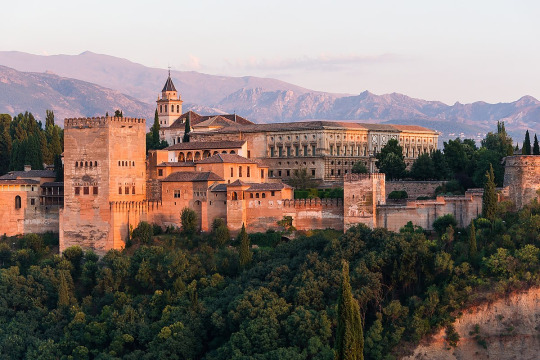
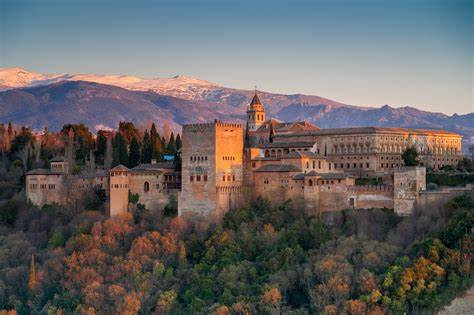
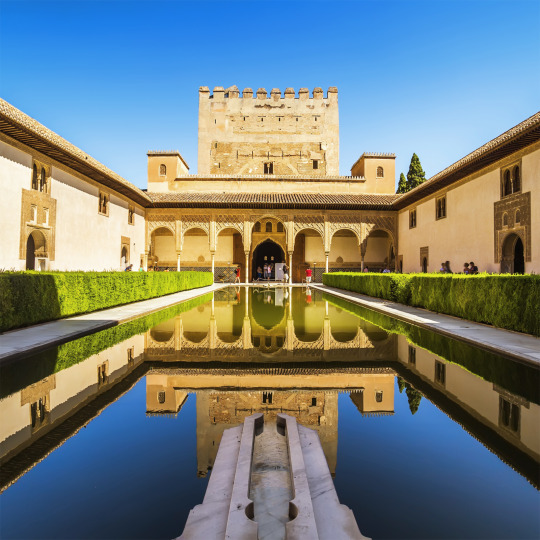
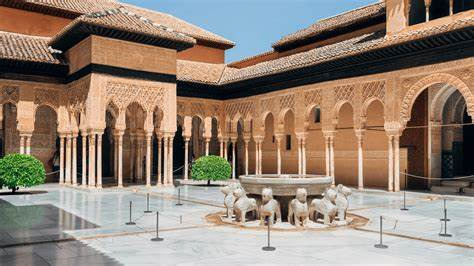
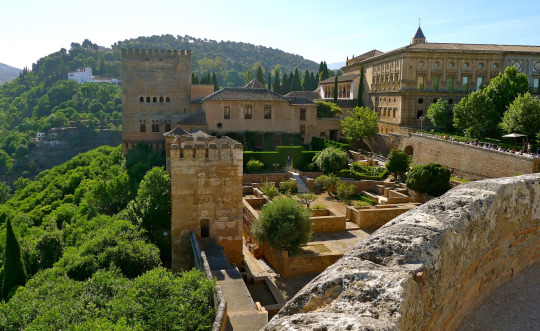
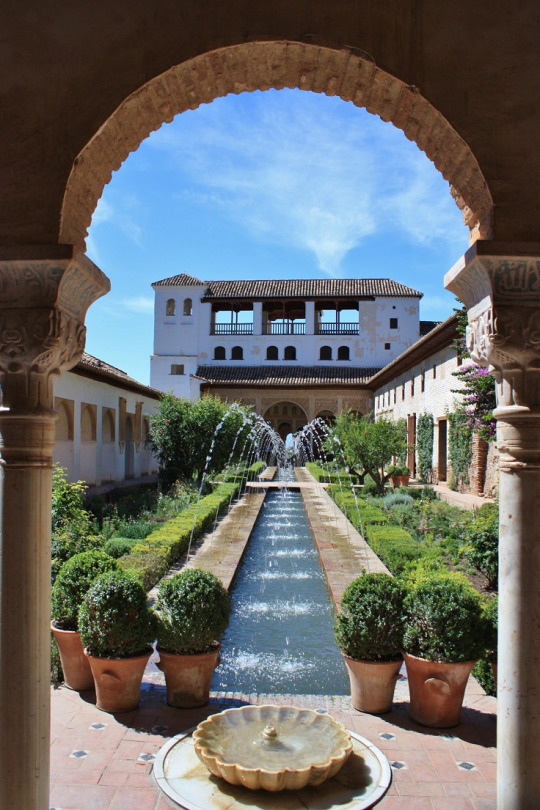
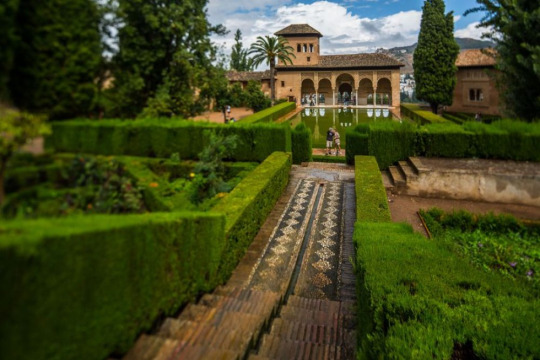

#al andalus#emirate of granada#islam#reconquista#alhambra#spain#iberian peninsula#architectures#european history#granada#andalusia#middle ages#renaissance#islamic garden#horticulture
49 notes
·
View notes
Text
Basil 101 - Ocimum selloi Benth.
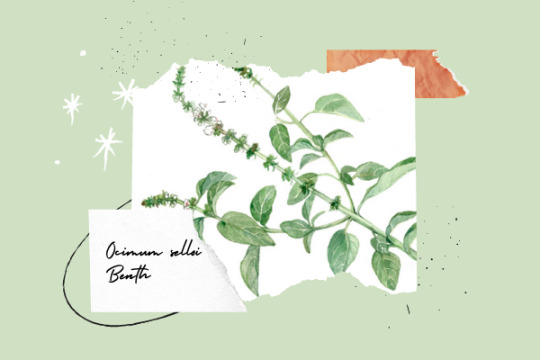
Name: Basil
Scientific name: Ocimum selloi Benth.
Disclaimer: Due my native language is not english, some scientific expressions can be wrong. I'm also using local resource.
History:
· Due to the shape of its leaves, (heart), it was considered a symbol of love, in Italy, and of mourning, in Greece. (Portal São Francisco, 2016)
· 4,000 years ago, the Hindus, who were percussionists in the culture of basil, exported to Egypt. (Portal São Francisco, 2016)
· In the last century, basil was used by shoemakers to attenuate the smell of leather. (Portal São Francisco, 2016)
· The name “basilicum” has its origin in the Greek “basilikós”, which means “of the kings, or royal”, to indicate its nobility. The Greek botanist of Theofrasto, in the 3rd century BC, defined basil as an herb of kings. (History of Ingredients, 2016).
Description: ·
Plant characteristics: Herbaceous plant grown in gardens and widely known throughout Brazil. It is characterized by the pleasant smell that is released from its leaves. It has a quadrangular stem and the leaves are opposite, sharp and in large numbers. White, small flowers, arranged on an elongated axis, always branching into 3 parts. Secondary inflorescences are formed on each axis, which are congested at the top of triflor. Bilabiated corolla with 4 pieces having 4 didamous stamens. Nucular fruit with 4 dark nuclei. It is a meliferous plant. It is multiplied by seeds or tips detached from the branches of branches in fertile soils rich in organic matter, permeable and with high temperatures. (Treatise on Medicinal Plants, 2014) ·
Propagation: it is made by seeds or cuttings of branches. Basil seeds are sown in 200-cell expanded polystyrene trays containing commercial substrate, kept in protected cultivation. At 30 days after sowing, the seedlings have four definitive leaves and are suitable for transplanting (PEREIRA; MOREIRA, 2011).
Cultivation: Seedlings can be planted in pots or in nurseries throughout the year. For this, the beds must be well prepared, raising them 15 cm high. Use 150 g of well-tanned bovine manure for each square meter of bed and mix well. Sow and cover with 0.5 cm of light soil or fine sawdust. The recommended spacing is 30 cm between lines and 30 cm between plants. Irrigate at least once a day, preferably in the early morning or late afternoon. After 60 days of planting in the beds, the first harvest can be made, with the plant being cut at 20 cm from the soil (PEREIRA; MOREIRA, 2011).
How to choose and where to find:
· Fresh: Fresh bunches and pots of basil are found in fairs, markets and supermarkets. Choose the branches with the most lush leaves and that are not stained or wilted.
· Dry: Found in supermarkets and emporiums. Prefer what is in dark packaging, protected from light. This prevents loss of aroma. Check the expiration date.
How to Store
· Fresh
1- the basil spoils quickly, but it can be packed in plastic packaging and dried, for up to three days at the most.
2- chop the leaves and place them in a closed glass, with oil.
· Dry: In a closed pool of light and humidity.
How to dry: ·
Buy two large bundles of basil, wash them well and spread them on a clean cloth until dry. Then, highlight the leaves and, in a glass bowl, make layers of leaves, alternating with thin layers of coarse salt. Cover the glass bowl with glass film and leave at room temperature. Stir once a day for the first three days. It can be used for two months. The leaves become dry and the salt acquires the aroma of basil. You can use only the leaves or also the coarse salt.
Chemical Constitution:
· Tannins: Tannins are astringent and hemostatic and, therefore, their therapeutic applications are related to these properties. They are mainly used in the tanning industry and are also used in the paint industry. They are used in laboratories to detect proteins and alkaloids and used as antidotes in cases of poisoning by alkaloid plants.
· Flavonoids: Therapeutically its function is not yet clearly clarified. The group is known for its anti-inflammatory, anti-allergic and vasoprotective effects (treatment of thrombosis). Rutin and hesperidin are important flavonoids used in capillary fragility treatments.
· Saponins: Saponoside glycosides have this name due to the fact that they form abundant foam when agitated with water (from Latin frog = soap). They taste bitter and acrid and the drugs that contain them are usually sternutatory (cause sneezing) and irritating to the mucous membranes. They are non-nitrogen compounds that dissolve in water giving afrogen solutions (foaming), by decreasing the surface tension of the liquid. They also have the properties of emulsifying oils and producing hemolysis. The latter is due to the ability of the glycoside to combine with the cholesterol molecules present in the erythrocyte membrane, disturbing the internal-external balance and promoting the rupture of the cell with the consequent release of hemoglobin.
· Essential oil:
o Thymol - has carminative, anti-spasmodic, expectorant and anti-inflammatory properties. Significant antiseptic potential.
o Methyl-chavicol - antimicrobial, anti-inflammatory, local anesthetic and insecticide activities
o Linalool - used for its woody, floral and refreshing aroma. o Eugenol - anesthetic, bactericidal and antifungal and flavoring properties (hot and spicy note)
o Cineol - decongestant and anti-inflammatory property, eucalyptus aroma the
o Pyrene
Herbal Actions:
Digestant: An herb that promotes good digestion.
Carminative: Herbs or essential oils that help the intestines release gas. They work by relaxing the gut spasms and increasing the peristalsis so that it pushes the gas out.
Sweetener: It has the ability to sweeten.
Aperientes: Aperientes herbs are mild laxatives.
Indications:
Basil favors those who have difficult digestion, gas, heartburn, headaches as a result of heavy or inadequate food. It facilitates the functioning of the intestines, it is a diuretic. It is good for coughs, vomiting, bad breath. It helps, along with Malva and sage in mouth infections.
Magical uses (under observation of effectiveness):
Basil's scalding is great for those who are aggressive, angry and ready to explode. Take the rage away. Basil tea helps very restrained people to release love. It can also be placed in pots to prevent the entry of negative energies. Basil compresses (a paste piled with leaves) helps mothers who have painful or cracked breasts after breastfeeding. Gargling with is great for sore throat, thrush or bad breath. It transmutes our aggressive energy, transforming it into will and strength to fight for more important things like goals and ideals. It helps to fight for life and for the things we want. It is great for the disorganized and undisciplined. Help us to see the brightness and the scent of life.
Dosage: There is little information on the safe or effective dosage of basil. Usually 10 to 20 ml of fresh basil leaf juice is used once a day or teas with an infusion of 2 grams of fresh basil or dried herb in boiling water twice a day.
Sources:
Basil relieves intestinal problems and has anti-inflammatory action (HERE)
Brazilian Society of Pharmacognosy (HERE)
Portal São Francisco (HERE)
History of Ingredients (HERE)
Treatise on Medicinal Plants (Download the book: HERE)
#green witch#witchblr#pagan witch#witchcraft#basil#materia magica#madamsaturn#mine#herbal#holisitichealth#plantas#plants#medicinal plants#101
12 notes
·
View notes
Photo

Casa Meco is a minimal residence located in Meco, Portugal, designed by Atelier RUA. The triangular shaped plot has a total area of 13.850 m2 and is oriented South/North. The path to the plot runs alongside a white wall, showing the way to the entrance. Entering the plot, the building reveals itself. A perfect square with four similar facades. Facing south, a clearance in the garden holds the 15x5m swimming pool. The building is one story high. Shaded exterior terraces cut-out its quadrangular footprint. It is a volume composed of a large roof supported in its four corners by the volumes that correspond to the private spaces of the program.
23 notes
·
View notes
Photo

House in Cumbres de Santa Fé designed by @landasuberville Read more: link in bio! This house is located in a subdivision to the west of Mexico City. Its solution responds to a very strict regulation, which establishes limits of height and land occupation. Thus, the house is a quadrangular prism that occupies the total allowed area with its spaces organized around terraces and a double-height atrium roofed by a concrete pergola. This atrium contains a floating steel and wood staircase. Coated with wood and travertine marble, the atrium acquires a different character at different times of the day; sunlight filters through the pergola and ignites the space with warm colour reflections. Project name: House in Cumbres de Santa Fé Architecture firm: Landa Suberville, Mónica Suberville and Agustín Landa Collaborators: Carolina Arriaga, Elena Cavazos, Galia González, Úrsula Arellano Construction: Constructor: Arquitronco S de RL de CV, Structure: Cafel Ingeniería SC Location: Cumbres de Santa Fe, Mexico City, Mexico Year: 2019 Area: 587 m² Photography: Onnis Luque @onnisluque_fotografia #cdmx #mexico #awesome #архитектура www.amazingarchitecture.com ✔ A collection of the best contemporary architecture to inspire you. #design #architecture #picoftheday #amazingarchitecture #style #nofilter #architect #arquitectura #luxury #realestate #life #cute #architettura #interiordesign #photooftheday #love #travel #instagood #fashion #beautiful #archilovers #architecturephotography #home #house #amazing #معماری (Cumbres de Santa Fe) https://www.instagram.com/p/B91_PVcFGHP/?igshid=dnvvdi3kfs26
#cdmx#mexico#awesome#архитектура#design#architecture#picoftheday#amazingarchitecture#style#nofilter#architect#arquitectura#luxury#realestate#life#cute#architettura#interiordesign#photooftheday#love#travel#instagood#fashion#beautiful#archilovers#architecturephotography#home#house#amazing#معماری
10 notes
·
View notes
Text
Open Starter

The Windowless Building.
Also known as the Calculate Fortress, it was a structure that stood within the middle of the city, at the center of School District 7. As its namesake implies, the building was indeed devoid of any windows or visible entrances to the interior. It was said to be able to withstand a nuke and it was also a spaceship that could take off whenever the owner of this fortress desired.

Inside it were no corridors, stairs, or air ducts of any kind and instead there was an area inside the building which was shown as a quadrangular chamber of sorts where a certain “Human” resided. The chamber's walls and ceilings are covered with tubes and pipes and it was notably chilly, despite the lack of ventilation in the building. The room's most notable feature is the single glass cylinder that usually houses that “human” connected to his life support system, housing several wires and cables, and filled with red fluid which tints the room with its color.
He was a human who looked like a man, yet also a woman, an adult, yet also a child, and a saint, yet also a sinner. His long silver hair spread about as he floated upside down in that cylindrical space as multiple displays were featured.
He was the founder, leader, and General Superintendent of Academy City, Aleister Crowly. Normally, he would not be able to gain any visitors without the use of a Teleportation Esper to bring them to him, but since that Esper was no longer around and he was not expecting any one to enter his space uninvited, the “human” was genuinely curious as to why the Intruder was there and what their intentions were. He was in control of this space, so if they tried anything, he could kill them instantly if he wanted.

“Oh? I was not expecting any guests at this time... care to tell me why you are here?”
3 notes
·
View notes